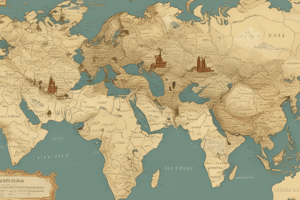Podcast
Questions and Answers
What is the Silk Road?
What is the Silk Road?
A network of ancient trade routes.
What did the Silk Road enable between regions?
What did the Silk Road enable between regions?
Exchange of goods, ideas, and cultures.
What was the initial focus of the Silk Road trade?
What was the initial focus of the Silk Road trade?
Silk exchange between China and the Roman Empire.
When did the Silk Road's origins begin?
When did the Silk Road's origins begin?
What did the Silk Road connect?
What did the Silk Road connect?
What were the two most famous routes of the Silk Road?
What were the two most famous routes of the Silk Road?
Who was the Chinese envoy dispatched by the Han Emperor to establish trade relations with the Western regions?
Who was the Chinese envoy dispatched by the Han Emperor to establish trade relations with the Western regions?
Which Venetian explorer traveled to China via the Silk Road?
Which Venetian explorer traveled to China via the Silk Road?
What factors contributed to the decline of the Silk Road's golden age?
What factors contributed to the decline of the Silk Road's golden age?
Despite its decline, what persisted in the cultural and intellectual exchange between the East and the West?
Despite its decline, what persisted in the cultural and intellectual exchange between the East and the West?
How does the term 'Silk Road' relate to modern forms of communication and trade?
How does the term 'Silk Road' relate to modern forms of communication and trade?
What does the Silk Road serve as a reminder of, in terms of human spirit?
What does the Silk Road serve as a reminder of, in terms of human spirit?
Flashcards are hidden until you start studying
Study Notes
Navigating the History of the Silk Road
The Silk Road, a network of ancient trade routes that stretched across vast expanses of land, has captivated historians and storytellers for centuries. This intricate web of paths facilitated the exchange of goods, ideas, and cultures between regions that were once isolated, bridging the East and the West.
Origins
The term "Silk Road" initially referred to the exchange of silk between China and the Roman Empire. However, like all great narratives, it is more complex than this simple trade. Merchants, missionaries, and adventurers traversed the routes, sharing knowledge about agriculture, medicine, religion, and art. The routes connected the great civilizations of China, India, Persia, and the Mediterranean, enabling the growth of trade and cultural exchange.
Evolution
The Silk Road's origins can be traced back to the 2nd and 3rd centuries BCE, during the Han Dynasty in China. But it wasn't until around the 1st century CE that the routes began to connect more regularly. As time passed, the Silk Road expanded to include new routes and cultures, becoming a vital artery of trade, culture, and knowledge exchange between East and West.
Routes
The Silk Road consisted of several overland and maritime trade routes spanning thousands of miles. The two most famous routes are the Northern and the Southern Silk Roads. The Northern Silk Road extended from Chang'an (present-day Xi'an) in China to the Mediterranean, facilitating trade with the Parthian Empire and the Roman Empire. The Southern Silk Road, running parallel to the northern route, connected China with India, Southeast Asia, and the Middle East.
Travellers and Merchants
The Silk Road brought together an array of merchants, explorers, and missionaries. Among the most famous travelers were Zhang Qian, the Chinese envoy dispatched by the Han Emperor to establish trade relations with the Western regions; and Marco Polo, the Venetian explorer who traveled to China via the Silk Road. These travelers left invaluable records of their adventures and the world they encountered, providing historians with insight into the culture, daily life, and trade practices of the time.
Decline
The fall of the Roman Empire and the rise of Islam led to the decline of the Silk Road and the end of its golden age. However, some routes continued to be used for trade, and the legacy of the Silk Road persisted in the cultural and intellectual exchange between the East and the West.
Modern-day Legacy
The Silk Road's remarkable story continues to inspire scholars, writers, and filmmakers. Today, the term "Silk Road" is also used to describe modern forms of communication and trade on the internet. The legacy of the Silk Road transcends time, serving as a testament to the power of human connection and the enduring spirit of exploration.
As we navigate the history of the Silk Road, we gain a deeper appreciation for the rich tapestry of human experience, where trade, culture, and knowledge intersect, driving us forward with curiosity and wonder. The Silk Road remains a tangible reminder of the human spirit's endless thirst for adventure, discovery, and connection.
Studying That Suits You
Use AI to generate personalized quizzes and flashcards to suit your learning preferences.




